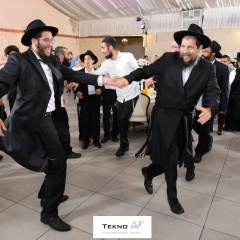Учили сегодня на Ваське Двар Малхус на главу Итро ...
кратко
Исрей. Содержание.
1. 10 Речений записаны в Торе дважды: в «Исрей» и в «Воэсханан». Надо понять содержание этих двух изложений, в особенности потому, что эти «речения» — основа и фундамент всей Торы, включают всю Тору, — выражают 2 некоторые идеи в Торе, в целом.
Предположимо, что те текстовые отличия, которые имеются между «первыми» и «последними» речениями, являются следствием общей разницы между ними.
2. Общая и простая разница: «первые речения» в «Исрей» произносятся самим Б-гом, «вторые» же являются частью слов Мейше, его повторения Торы. Поскольку Тора несет в себе вечное указание, понятно, что эти два способа произнесения 10 речений есть во всех идеях Торы и в Служении еврея по изучению Торы и выполнению заповедей во все времена. А поскольку слова Торы каждый день должны быть в глазах еврея новыми, это должно присутствовать в Служении еврея ежедневно.
Тогда нуждается в объяснении: что прибавляет произнесение речений Мейше к первому произнесению их Б-гом?
3. Объяснение:
В Торе есть 2 ступени:
(а) Тора, с точки зрения ее самой, «скрытая драгоценность, хранимая для Тебя… до того, как был сотворен мир», мудрость и воля Б-га, вплоть до того, что «Тора и Б-г — в абсолютной степени одно».
(б) Потом Тора спускается, одевается в материальные вещи, т.д., передается евреям именно вниз, на Землю, «не на Небесах она». Евреи, будучи душами в телах, должны учить ее, совершать выводы, т.д., пользоваться Торой и заповедями для создания «жилища в нижних».
4. Из этих двух ступеней следуют 2 идеи, которые должны наличествовать в изучении Торы:
(а) Понимание, что Тора — мудрость и воля Б-га и выше всех идей мира, включая человеческий разум. Это выражает битуль изучающего к Б-гу. И до изучения (Письменной Торы) он должен произносить благословение, даже если он не понимает смысла произносимых слов. «Ответит язык мой речению Твоему», «Г-сподь, открой мои уста…» т.п., — речь человека — речь Б-га, наподобие «Шхина говорит из его горла». — Поэтому ощущения человека при изучении Торы могут быть такими же, как при Даровании Торы.
(б) Знание того, что Тора дана именно вниз, на Землю душе в теле. Это раскрывает еврею, что должно наличествовать существование человека, чтобы он учил Тору и старался понять ее своим разумом. «…называется его именем». Еврей становится «хозяином» над Торой.
http://sominski.com/mp3/02_Shmeis/08_Isrei/Isrei_01.mp3
кратко
Исрей. Содержание.
1. 10 Речений записаны в Торе дважды: в «Исрей» и в «Воэсханан». Надо понять содержание этих двух изложений, в особенности потому, что эти «речения» — основа и фундамент всей Торы, включают всю Тору, — выражают 2 некоторые идеи в Торе, в целом.
Предположимо, что те текстовые отличия, которые имеются между «первыми» и «последними» речениями, являются следствием общей разницы между ними.
2. Общая и простая разница: «первые речения» в «Исрей» произносятся самим Б-гом, «вторые» же являются частью слов Мейше, его повторения Торы. Поскольку Тора несет в себе вечное указание, понятно, что эти два способа произнесения 10 речений есть во всех идеях Торы и в Служении еврея по изучению Торы и выполнению заповедей во все времена. А поскольку слова Торы каждый день должны быть в глазах еврея новыми, это должно присутствовать в Служении еврея ежедневно.
Тогда нуждается в объяснении: что прибавляет произнесение речений Мейше к первому произнесению их Б-гом?
3. Объяснение:
В Торе есть 2 ступени:
(а) Тора, с точки зрения ее самой, «скрытая драгоценность, хранимая для Тебя… до того, как был сотворен мир», мудрость и воля Б-га, вплоть до того, что «Тора и Б-г — в абсолютной степени одно».
(б) Потом Тора спускается, одевается в материальные вещи, т.д., передается евреям именно вниз, на Землю, «не на Небесах она». Евреи, будучи душами в телах, должны учить ее, совершать выводы, т.д., пользоваться Торой и заповедями для создания «жилища в нижних».
4. Из этих двух ступеней следуют 2 идеи, которые должны наличествовать в изучении Торы:
(а) Понимание, что Тора — мудрость и воля Б-га и выше всех идей мира, включая человеческий разум. Это выражает битуль изучающего к Б-гу. И до изучения (Письменной Торы) он должен произносить благословение, даже если он не понимает смысла произносимых слов. «Ответит язык мой речению Твоему», «Г-сподь, открой мои уста…» т.п., — речь человека — речь Б-га, наподобие «Шхина говорит из его горла». — Поэтому ощущения человека при изучении Торы могут быть такими же, как при Даровании Торы.
(б) Знание того, что Тора дана именно вниз, на Землю душе в теле. Это раскрывает еврею, что должно наличествовать существование человека, чтобы он учил Тору и старался понять ее своим разумом. «…называется его именем». Еврей становится «хозяином» над Торой.
http://sominski.com/mp3/02_Shmeis/08_Isrei/Isrei_01.mp3
They taught today at Vaska Dvar Malhus the head of Itro ...
briefly
Isrey. Content.
1. 10 Speeches are recorded in the Torah twice: in “Israi” and in “Voeskhanan”. It is necessary to understand the content of these two statements, especially because these “utterances” - the basis and foundation of the entire Torah, include the entire Torah, - 2 express some ideas in the Torah as a whole.
Suppose that the textual differences that exist between the “first” and “last” sayings are a consequence of the general difference between them.
2. The general and simple difference: the "first utterances" in "Israi" are pronounced by Gd himself, the "second" are part of Meisha’s words, his repetition of the Torah. Since the Torah carries an eternal instruction, it is clear that these two ways of making 10 sayings are in all the ideas of the Torah and in the Jewish Ministry for the study of the Torah and the fulfillment of the commandments at all times. And since the words of the Torah should be new in the eyes of the Jew every day, this should be present in the Jewish Ministry daily.
Then he needs an explanation: what adds the utterance of the Meisha utterances to the first utterance of them by Gd?
3. Explanation:
There are 2 steps in the Torah:
(a) The Torah, from the point of view of itself, is “a hidden treasure that is stored for You ... before the world was created,” the wisdom and will of God, to the extent that “the Torah and God is to an absolute extent one thing. "
(b) Then the Torah descends, dresses in material things, etc., is transferred to the Jews precisely down to Earth, "it is not in Heaven." Jews, being souls in bodies, must teach it, draw conclusions, etc., use the Torah and the commandments to create a "home in the lower."
4. From these two steps, 2 ideas follow that should be present in the study of the Torah:
(a) Understanding that the Torah is the wisdom and will of God and above all the ideas of the world, including the human mind. This expresses the student's bitul to Gd. And before studying (the Written Torah), he must pronounce a blessing, even if he does not understand the meaning of the words spoken. “My tongue will answer Thy utterance”, “Gd, open my mouth ...” etc., - a man’s speech - a Gd’s speech, like “Shekhina speaks from his throat”. - Therefore, the sensations of a person when studying the Torah can be the same as when giving the Torah.
(b) The knowledge that the Torah is given precisely down to the soul of the earth in the body. This reveals to the Jew that the existence of man must be present so that he will teach the Torah and try to understand it with his mind. "... called by his name." A Jew becomes a "master" over the Torah.
http://sominski.com/mp3/02_Shmeis/08_Isrei/Isrei_01.mp3
briefly
Isrey. Content.
1. 10 Speeches are recorded in the Torah twice: in “Israi” and in “Voeskhanan”. It is necessary to understand the content of these two statements, especially because these “utterances” - the basis and foundation of the entire Torah, include the entire Torah, - 2 express some ideas in the Torah as a whole.
Suppose that the textual differences that exist between the “first” and “last” sayings are a consequence of the general difference between them.
2. The general and simple difference: the "first utterances" in "Israi" are pronounced by Gd himself, the "second" are part of Meisha’s words, his repetition of the Torah. Since the Torah carries an eternal instruction, it is clear that these two ways of making 10 sayings are in all the ideas of the Torah and in the Jewish Ministry for the study of the Torah and the fulfillment of the commandments at all times. And since the words of the Torah should be new in the eyes of the Jew every day, this should be present in the Jewish Ministry daily.
Then he needs an explanation: what adds the utterance of the Meisha utterances to the first utterance of them by Gd?
3. Explanation:
There are 2 steps in the Torah:
(a) The Torah, from the point of view of itself, is “a hidden treasure that is stored for You ... before the world was created,” the wisdom and will of God, to the extent that “the Torah and God is to an absolute extent one thing. "
(b) Then the Torah descends, dresses in material things, etc., is transferred to the Jews precisely down to Earth, "it is not in Heaven." Jews, being souls in bodies, must teach it, draw conclusions, etc., use the Torah and the commandments to create a "home in the lower."
4. From these two steps, 2 ideas follow that should be present in the study of the Torah:
(a) Understanding that the Torah is the wisdom and will of God and above all the ideas of the world, including the human mind. This expresses the student's bitul to Gd. And before studying (the Written Torah), he must pronounce a blessing, even if he does not understand the meaning of the words spoken. “My tongue will answer Thy utterance”, “Gd, open my mouth ...” etc., - a man’s speech - a Gd’s speech, like “Shekhina speaks from his throat”. - Therefore, the sensations of a person when studying the Torah can be the same as when giving the Torah.
(b) The knowledge that the Torah is given precisely down to the soul of the earth in the body. This reveals to the Jew that the existence of man must be present so that he will teach the Torah and try to understand it with his mind. "... called by his name." A Jew becomes a "master" over the Torah.
http://sominski.com/mp3/02_Shmeis/08_Isrei/Isrei_01.mp3
У записи 2 лайков,
1 репостов.
1 репостов.
Эту запись оставил(а) на своей стене Хаим Толочинский























